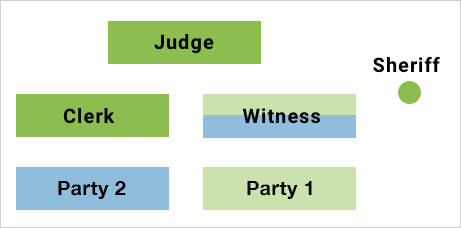Going to court can be stressful, especially if you've never been in court before. But there are some things you can do before your court date to make it a bit less stressful.
Here are some tips to help you get ready for a Provincial Court trial.
Find out what happens in court
If you know what to expect when you're in court, you'll probably be a bit less anxious before you go.
See how the courtroom's set up
You'll probably feel a bit more comfortable if you know how the courtroom will be set up, who'll be there, and where they sit.
Here's a diagram showing how most family courts in BC are set up:
The people who work in the courtroom include:
- the judge, who hears the case and makes orders;
- the court clerk, who:
- keeps the family court files,
- receives exhibits (like letters and documents) from witnesses, and
- operates the tape recorder that records all evidence given at trial; and
- the sheriff, who pages witnesses who aren't in the courtroom and makes sure the courtroom stays safe.
Watch a family court case before the day of your trial
Family court is open to the public. That means you can watch someone else's family court trial to get a good idea of what to expect at your own trial.
Phone the family court registry or ask at the registry counter to find out when a family court trial is happening.
A court clerk or sheriff might ask you why you want to watch. Tell them you have a case coming up and want to see what happens.
If you watch trials in person at the courthouse, you can sit and watch for as long as you like. If you watch virtual trials, you might only be able to watch one trial.
Know what can happen in at the trial
If you and the other person (the law calls them the other party) are both in court, this is what will happen:
- All the witnesses will be asked to leave the courtroom and wait outside until they're called to give evidence.
- The person who made the application and their witnesses will give evidence and be cross-examined by the other person or their lawyer.
- The other person and their witnesses will give evidence and be cross-examined.
- The judge might ask questions or give instructions about the trial process.
- The applicant and respondent will each sum up their case (give a short version of the main points).
- The judge will make a decision.
Get organized: Make a trial book
Lawyers use trial books to:
- organize their evidence
- write information about what their witnesses will say
- write the main questions they need to ask to prove things that are important to the case
It's a good idea to make your own trial book. You'll need:
- one 1-inch (2.5 cm) three-ring binder
- five dividers
- one 9-inch x 12-inch (23 cm x 30 cm) envelope.
Divide your trial book into four sections:
- Trial preparation worksheet
- Evidence
- Cross-examination
- Summation
To find out more about what will happen when you go to court, see:
- What happens at a Provincial Court family law trial? and
- the Justice Education Society's Guidebooks for Representing Yourself. They're about representing yourself in a civil trial, but civil trials follow the same rules as family trials, so you might still find them helpful.
And see our Checklist of information to include in an affidavit or bring to court for more helpful tips about how to get organized.
Going to court can be hard on your mental and physical health. Be kind to yourself.

